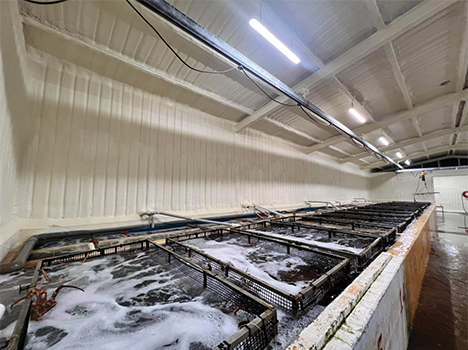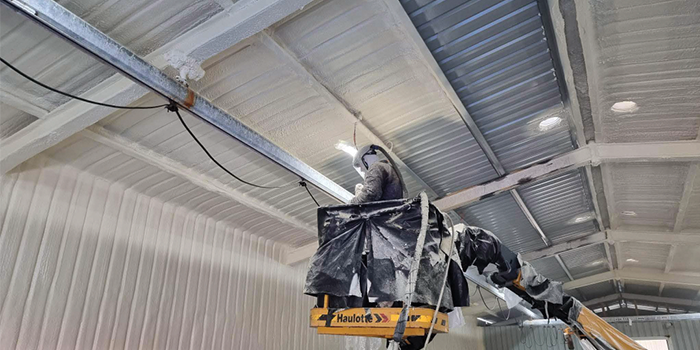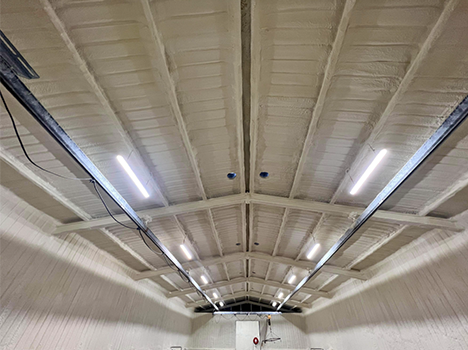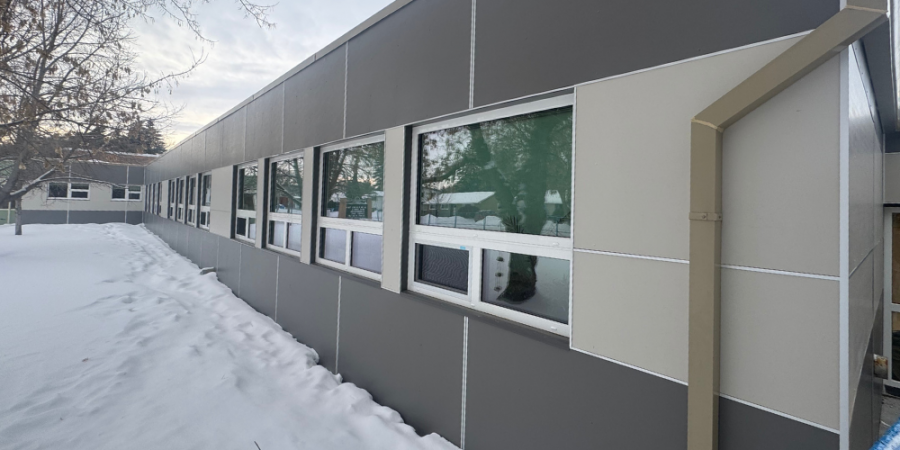A Pinch of Good Fortune


SPRAY FOAM MAGAZINE – Spray polyurethane foam is highly regarded in the U.S. for its versatile insulating capabilities. But it’s less well-known in other areas around the world, like the Australian island of Tasmania. Roofing expert-turned insulation professional Ryan Worn founded Spray Foam Insulation Tasmania with the goal of making Tasmania more energy-efficient, one structure at a time. Though Worn only officially started the business about a year and a half ago, he and his team have already served a slew of residential clients and a few major commercial ones as well – the most notable being the SALCO Live Lobster Farm in the coastal town of Bicheno, Tasmania.
The South Australian Lobster Company (SALCO) holds the title of Australia’s largest exporter of Jasus edwardsii, commonly known as Southern Rock Lobsters. SALCO’s partner brand Wild Legend distributes locally caught lobsters to individuals and establishments all over Australia and New Zealand. They take pride not only in the luscious quality of their lobster livestock, but in their commitment to sustainability practices at every level of the supply process. SALCO partners with local fishermen to gather fresh, wild-caught lobsters perfect for luxurious fine dining experiences and sensual home cooking. Naturally, SALCO also wishes to maintain energy efficiency at their facilities.
Any farm that manages livestock has a certain set of standards and best practices to follow, and lobster farms are no exception. Calling SALCO’s facilities a “farm” oversimplifies their process.

Lobster holding tanks line the walls inside the narrow housing sheds
In reality, the facilities are more like temporary nurseries where the live lobsters are housed in holding tanks before being shipped to other destinations, like restaurants or supermarkets. The housing sheds contain lobster holding tanks, both of which must meet specific temperature specifications to keep the lobsters healthy and alive. Unfortunately for SALCO, it proved difficult to maintain climate control in their drafty, old, metal buildings. When executives at SALCO noticed their Bicheno holding sheds were struggling to maintain the correct ambient temperatures, they weighed their options for correcting the problem. At first, they believed their only solution was to demolish their two existing lobster holding sheds and build a single large warehouse. After estimating construction costs at well over a million dollars, they searched for alternative solutions to revamp their facilities. Their search soon led them to Spray Foam Insulation Tasmania, a brand-new company and the first of its kind on the entire island. It was perfect timing.
If you had told Ryan Worn three years ago that one day he’d lead the only spray foam company in Tasmania in servicing the largest lobster distributor in Australia, he’d probably have laughed before asking, “spray what?” Spray foam insulation was barely on his radar until 2020, when he attended the International Roofing Expo in Dallas, Texas. It was at this expo where he’d get his first taste of the world of spray foam and become hungry for all the information he could get about this new type of insulation.
“It was like my head exploded.” Worn exclaims. “For the rest of the trip I felt like a zombie, all I could think about was spray foam. I knew I had to get a jump on this idea, even though I didn’t quite know where to start.”
Worn had worked in the construction trade for most of his life and owned his own roofing company. He wasn’t a stranger to the construction side of things nor the business side of things and knew that spray foam insulation had the potential to catch on in Australia in a major way. As a roofer, he’d seen firsthand that many of the buildings in Australia, especially houses, were old and drafty due to the lack of insulation in both the attics and the crawl spaces.
“There are stories in the papers everyday about properties that are too cold and cost too much to warm up. And now here comes our company with a new way of insulation that can solve a lot of those problems, which can be life changing for some people.” Worn explains.

Lead applicator Greg Priest applies spray foam to the ceiling of one of SALCO’s holding sheds.
Though Worn was sure he had a profitable business idea from the get-go, he didn’t take any chances or cut any corners. In the beginning, Worn researched the ins and outs of running a spray foam company, consulting YouTube for recommendations on equipment and other products. It wasn’t long before he had other people excited about the potential business as well. His co-founder, Tom Allison, previously worked in the hospitality industry, and really wanted a career change. He approached Worn looking for advice about breaking into the construction industry. When Worn told him about his spray foam idea, Allison was quick to seize the opportunity and signed on as a co-founder of Spray Foam Insulation Tasmania.
Worn recalls his business partner’s enthusiasm, which has grown in proportion to their business success: “Tom got on board and really loves it. He constantly sends me messages at midnight about new things he’s learned and wants me to look into.”
Prior to launch, the two went through the proper compliance channels, and underwent the necessary training to give them the best leg up in the industry. Their installers all hold certifications from the Energy Efficiency Council along with Electrical Contractor licenses. Just as they were gearing up to launch the business in 2021, luck befell them in the form of Greg Priest, a spray foam applicator from Sydney with over 26 years of spray foam experience. Priest’s mother lived in Tasmania, and he planned to relocate to the island to live closer to her. The stars had aligned for all involved, and Priest accepted a position as lead applicator at Spray Foam Insulation Tasmania. Both Worn and Allison valued Priests’ experience and skill as a spray foam applicator and trusted him to make important decisions, such as which products to buy and what techniques to utilize. After a few free test runs applying foam to their own residences and for family members, they started taking on their first batch of residential clients, which would soon snowball into larger, more high-profile commercial jobs like the SALCO Lobster Farm.
Residential clients loved the positive effect spray foam insulation had on reducing their power bills by shoring up their drafty homes. Like the residential clients, SALCO experienced insulation and energy efficiency issues, but they also experienced problems caused by the age of the lobster housing sheds. The buildings were about 40 years old and their age was growing apparent based on the wear-and-tear on the steel walls. In addition to draftiness, small gaps in the flimsy steel walls allowed birds and other pests to get in– not ideal for any structure, let alone one housing live lobsters. Applying closed-cell foam to the interior walls provided a cost-effective way to increase the integrity and longevity of the structure, in addition to its superior insulating abilities. Instead of spending millions of dollars on a brand-new building, SALCO opted to use closed-cell foam to extend the life of the existing buildings and improve their energy efficiency.
In April of 2023, Worn and his team of four applicators set out to SALCO’s Bicheno facility to begin the spraying process. The lobster housing sheds they worked in were long and narrow, with holding tanks on both sides. Because the workspace was so narrow, they used a cherry picker in lieu of a scissor lift to reach every corner of the buildings. The skilled applicators used a Reactor 3 E-20 to cover every inch of the interior walls and ceiling with two inches of UrePac foam, working in one-inch layers at a time.
Strict adherence to safety protocols is integral to their business, and all applicators wore protective suits, gloves, and a fully-shielded face mask. SALCO removed all lobsters from the buildings prior to spraying. They also covered the empty holding tanks with protective plastic tarps, and switched
out the water before placing the lobsters back in the tanks post-spray.
In all, the project took approximately three weeks from start to finish. The process was a bit stop-and-start considering the nature of SALCO’s operations, which Worn and his team tried hard not to interrupt. The facility had two separate holding sheds equipped with water-filled lobster holding tanks. Prior to spraying, SALCO transferred the lobsters from one building to the other. The process of moving the lobsters often delayed spraying, particularly on days when SALCO received big deliveries.
Heavy condensation on the walls also slowed the spraying process, and in Tasmania, daily condensation is just a fact of life. On days where there was too much condensation in the air, the applicators had to wait for hours until conditions dried up or else the foam would not adhere to the steel substrate correctly. On particularly wet days, they were unable to begin spraying until mid-afternoon and could only work for a few hours until the humid evenings restarted the condensation issues all over again. Despite these roadblocks, Worn and his team continued to impress SALCO’s leadership with the quality of their products and services.
“We were actually only supposed to do about three quarters of the work we ended up doing, because management was so impressed, they kept asking ‘can you come do this and that, here and there.’ They couldn’t believe how well the foam worked.”

SALCO joined the ranks of Spray Foam Insulation Tasmania’s collection of happy customers, and even sent Worn and his team home with some complimentary lobsters to show their gratitude. Though large commercial clients like SALCO remain few and far between in comparison to their steady stream of residential clients, Worn remains optimistic about spray foam insulation’s staying power in Tasmania.
He recalls the trepidation a few clients initially had about spray foam:
“They’d call me up and the first thing they’d ask is, ‘is this stuff poisonous?’” Worn laughs. “That hesitancy came from the fact that we were the only spray foam company around, and people here are just not as familiar with spray foam as they are in the States.”
But as SALCO can vouch, the quality of the product and the professionalism of Worn’s team speaks for itself. Just as they gained new residential customers through word-of-mouth advertising from satisfied clients, so too will they gain new commercial clients like SALCO, who are eager to see how this newfangled spray foam stuff can enhance their businesses.
For use by SprayFoamMagazine.com & Spray Foam Magazine
Disqus website name not provided.









































